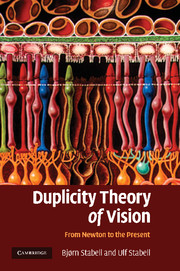Book contents
- Frontmatter
- Contents
- Acknowledgements
- 1 Introduction
- Part I The development of the basic ideas of the duplicity theory from Newton to G. E. Müller
- Part II The development of the duplicity theory from 1930–1966
- Part III Chromatic rod vision: a historical account
- Part IV Theories of sensitivity regulation of the rod and cone systems: a historical account
- 15 Introduction
- 16 Early photochemical explanations
- 17 Contribution of S. Hecht
- 18 Contribution of G. Wald: photochemical sensitivity regulation mechanisms of rods and cones
- 19 Relationship between amount of rhodopsin and sensitivity during dark adaptation
- 20 Post-receptor sensitivity regulation mechanisms
- 21 Rushton's AGC model
- 22 Contribution of H.B. Barlow
- 23 Rushton and Barlow compared
- 24 The Dowling-Rushton equation refuted
- 25 Several mechanisms involved in sensitivity regulation
- 26 Sensitivity regulation due to rod-cone interaction
- 27 Modern conceptions of sensitivity regulation
- Part V Factors that triggered the paradigm shifts in the development of the duplicity theory
- References
- Index
15 - Introduction
Published online by Cambridge University Press: 22 January 2010
- Frontmatter
- Contents
- Acknowledgements
- 1 Introduction
- Part I The development of the basic ideas of the duplicity theory from Newton to G. E. Müller
- Part II The development of the duplicity theory from 1930–1966
- Part III Chromatic rod vision: a historical account
- Part IV Theories of sensitivity regulation of the rod and cone systems: a historical account
- 15 Introduction
- 16 Early photochemical explanations
- 17 Contribution of S. Hecht
- 18 Contribution of G. Wald: photochemical sensitivity regulation mechanisms of rods and cones
- 19 Relationship between amount of rhodopsin and sensitivity during dark adaptation
- 20 Post-receptor sensitivity regulation mechanisms
- 21 Rushton's AGC model
- 22 Contribution of H.B. Barlow
- 23 Rushton and Barlow compared
- 24 The Dowling-Rushton equation refuted
- 25 Several mechanisms involved in sensitivity regulation
- 26 Sensitivity regulation due to rod-cone interaction
- 27 Modern conceptions of sensitivity regulation
- Part V Factors that triggered the paradigm shifts in the development of the duplicity theory
- References
- Index
Summary
The most basic assumption of the orthodox duplicity theory that only rods function in night vision and only cones in day vision has been generally agreed on during the whole developmental period from Schultze (1866) to the present (2009).
Schultze had provided two strong arguments in favour of this basic assumption. Firstly, rods and cones tended to dominate in nocturnal and diurnal species, respectively. In fact, some nocturnal species had a pure rod and some diurnal species a pure cone retina. Secondly, colour vision, a characteristic feature of cones of the central fovea, was absent in night vision.
Reasoning from this assumption, one would expect that a reduction in light intensity from that of daylight would lead to the functional appearance of rods at some particular intensity level. Schultze, however, did not state where and how this transition from cone to rod vision and vice versa happened. Furthermore, he did not provide any theory to explain the difference in sensitivity between the two receptor types. This reveals a serious limitation in his theory construction and shows that the most basic assumption of his theory was without any adequate explanation.
Several of the leading scientists within vision research have attempted to bridge this gap in Schultze's theory construction by developing theories of the sensitivity regulation mechanisms ofthe rod and cone receptor systems. Actually, the development of these theories may be considered a main thread in the history of the duplicity theory.
- Type
- Chapter
- Information
- Duplicity Theory of VisionFrom Newton to the Present, pp. 132Publisher: Cambridge University PressPrint publication year: 2009



